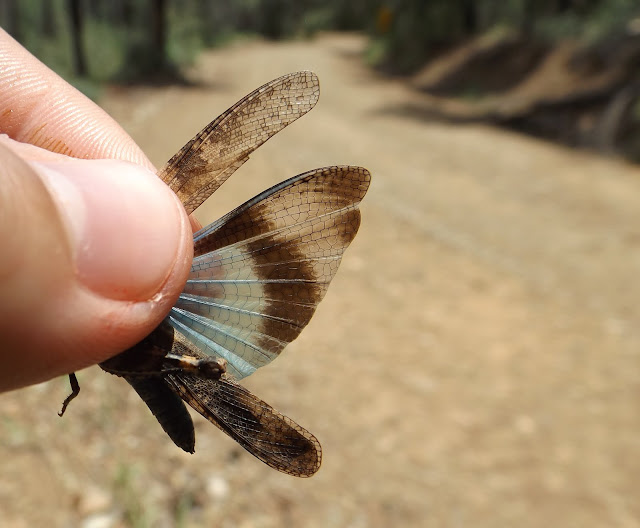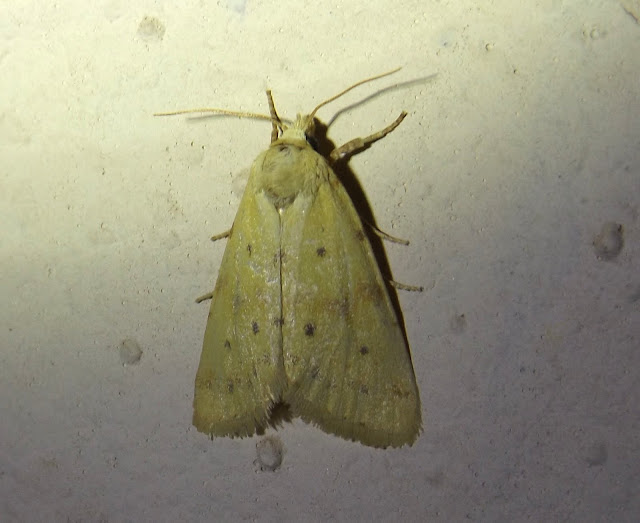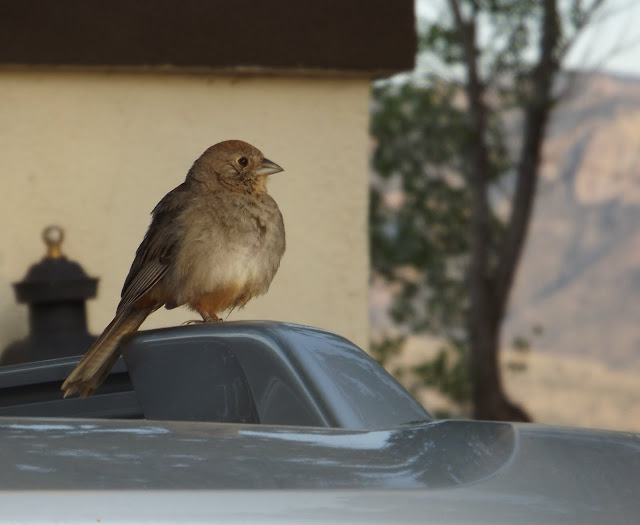It's been such a long time since I've posted! I started my 16 credit college semester in late August and haven't had much time for blogging (or birding for that matter). Although I haven't posted for a while, I still have a couple trips from this summer and fall to share. This one began in late July...
I received an email one day from the Tucson Audubon Society that was asking for two more volunteers to join "Team Audubon" for the Charlie H. Painter Memorial BioBlitz in Arizona's Chiricahua Mountains. I called my friend Caleb Strand and asked if he was up for it. Not surprisingly, he wanted to go and so we signed up for the event. A bioblitz is an event in which an area's biodiversity is censused. Although our group would be focusing on birds, I requested to manage the recording of all non-bird species. Our trip leader, Jennie MacFarland, granted me this honor. After much anticipation and study, Caleb and I set off towards Tucson to carpool with Jenny.
Upon arriving, we enjoyed meeting the other members of Team Audubon: Tim Helentjaris (birder and unofficial driver) and Emilia Hoyos (Audubon Society volunteer). We headed southeast of Tucson towards Rodeo, NM in Hidalgo County where the event's headquarters would be. Rodeo is a mere 10 minutes or so from the Arizona border and the Chiricahuas aren't much farther away. At the Chiricahua Desert Museum, each of us signed in for the event and Jenny determined where we would be birding for the bioblitz. She was very pleased to announce that we would be taking on the Chiricahua Mountains' high elevations as well as parts of Cave Creek Canyon! These are two of the best birding areas in Cochise County, so we couldn't complain. It was swiftly approaching 12 pm and we had to get out into the field to begin the count which would conclude in 24 hours...
 |
| Outside the event's headquarters at the Chiricahua Desert Museum |
 |
| Our view of the Chiricahuas in Arizona from HQ in New Mexico! |
Starting out east of Portal, we noted over a dozen species while driving through the open country and up into higher country. A Rufous Hummingbird, Vermilion Flycatcher, Cassin's Sparrow, Blue Grosbeak and Bronzed Cowbird were excellent additions to our day list which was now at 17...in only 10 minutes!
Heading even higher to Turkey Creek Road, we watched and listened while driving and found several new species; principally Brown-crested Flycatcher, Mexican Jay, Bridled Titmouse, Canyon Wren, Painted Redstart and Lark Sparrow. Upon reaching the intersection of Forest Roads 42 and 42B at East Turkey Creek, we spent 20 minutes scouring the area for birds and found some very nice species including Band-tailed Pigeon, Magnificent Hummingbird, Dusky-capped Flycatcher, Grace's Warbler, Yellow-eyed Junco and Hepatic Tanager. We were all blessed with good looks at a Red-faced Warbler which was foraging low in the branches of a pine; I believe it was Emilia's first.
 |
| A House Wren; likely the subspecies T. a. cahooni |
 |
| The common but local Yellow-eyed Junco (a species of sparrow) |
 |
| As the team's "non-avian specialist", I tried to identify various insects... |
 |
| This is the Blue-winged Grasshopper (Trimerotropis cyaneipennis) |
After our short but productive stop here, we gained more elevation and reached one of the highest points in the Chiricahuas; Rustler Park. There was one species here that we were all exceptionally excited for; this was the Mexican Chickadee. The core of the Mexican Chickadee's range is in Mexico and the species is restricted to Arizona's Chiricahua Mountains and New Mexico's Animas Mountains in the Unites States. Because Caleb had prior experience with the species, he knew where to look and we found two individuals calling high up in the pines along the ridge!
 |
| My sad record shot |
The northernmost subspecies of Mexican Chickadee (the one we saw) is P. s. eidos and is found south into Mexico's Sierra Madre Occidental. As we were straining our eyes to locate the chickadees far above us, another visitor made a brief appearance... an Olive Warbler (P. t. arizonae)! Other bioblitz additions included White-throated Swifts, a Northern Flicker (C. a. collaris), a Cordilleran Flycatcher, a dozen Pygmy Nuthatches and a couple Brown Creepers (presumably C. a. albescens).
 |
| My poor documentation of the well-camouflaged Brown Creeper (C. a. albescens) |
A short distance from Rustler Park is Barfoot Park; another high elevation destination of ours. This area has a history of rare Short-tailed Hawks, so we were especially vigilant. Although we failed to find the hawk, we did get an Acorn Woodpecker, two Hairy Woodpeckers (likely P. v. icastus) and a Steller's Jay (C. s. diademata). After Barfoot, our total for the 2.5 hours we birded had come to 56 species!
 |
| Ashy-gray Range Grasshopper (Horesidotes cinereus) |
From Barfoot, we decided to drive to the same spot in Pinery Canyon that an ABA code 4 Slate-throated Redstart had been frequenting previously this summer. We searched for it but could not find it. However, we enjoyed finding two more Mexican Chickadees and a flock of Bushtits nearby!
 |
Yarrow's
Spiny Lizard (Sceloporus jarrovii)
|
 |
Striped
Plateau Lizard (Sceloporus virgatus)
|
Our next stop would bring us some excellent new species. We were headed to the famous Southwestern Research Station; the place at which Caleb and I stayed during our Young Birders Camp from earlier in the summer. Arriving on the grounds of the research station at 4 pm, we made a beeline to the feeders... We found what we were looking for; Blue-throated Hummingbirds! The ones we see in Arizona are of the subspecies L. c. bessophilus. Another Southeastern Arizona specialty, the Arizona Woodpecker, made its way onto our list also. Our final addition from the station was a Summer Tanager (P. r. cooperi).
 |
| This young Yarrow's Spiny Lizard had been painted by a biologist working at the station...for science of course! |
 |
| Perhaps our best mammal of the trip was this Mexican Fox Squirrel (Sciurus nayaritensis) |
 |
| A mating pair of Large Milkweed Bugs (Oncopeltus fasciatus) |
 |
| Although we had recorded these earlier, it was fun to observe Lark Sparrows at close range at the station. |
 |
| Yes, it is a glorious Violet-crowned Hummingbird! My first ever. |
 |
| We were absolutely thrilled to see this rarity so well! |
 |
| A migrant Rufous Hummingbird |
But wait! There's more! This diverse assemblage of hummers was further improved by the appearance of my lifers Calliope (!!!) and Lucifer Hummingbird (!!!!!!!).
 |
| A fantastic male Calliope Hummingbird! |
 |
| My 3rd hummingbird lifer of the day, this Lucifer Hummingbird, is characterized by a decurved bill and pointed tail |
10 species of hummingbird in under 5 hours is proof that Southeast Arizona is a diverse and unpredictable place!
 |
| Seating for the birders that visit the feeders |
Just after 5:30 pm, we arrived at Dave Jasper's new yard in Portal which opened in 2015. Dave was very kind to open his yard and feeders to visiting birders. During our visit here, we found some of the more typical desert species such as Gambel's Quail, a Verdin, a Cactus Wren, Curve-billed Thrashers and a few Pyrrhuloxia.
Later, we visited Bob Rodriguez's yard which is also in Portal and found a Cliff Swallow and Canyon Towhee which were new for the count. Much to our surprise, we also discovered a second Lucifer Hummingbird!
 |
| The distinctive male Lucifer Hummingbird |
 |
| A male Blue Grosbeak was another nice observation at Bob's |
After an extraordinarily eventful 7 hours, we decided to leave Portal and head to Willow Tank which is located in the semi-desert grasslands which surround the Chiricahuas. We were able to acquire four new species for the BioBlitz: Killdeer, Lesser Nighthawks, a Common Poorwill, and two Eastern Meadowlarks!
 |
| The entrance to Willow Tank |
Stopping at our lodge, Four Bars Cottages (where we found a Ladder-backed Woodpecker), we rested for a bit and geared up for the night ahead of us. We had the possibility of owls in the near future! It was swiftly getting dark when we set out for Cave Creek Canyon in the Chiricahuas. By the time we had reached our destination at Stewart Campground, it was a little later than 8 pm. We began listening intently for any owl calls... As we were walking around, we found a Cooper's Hawk roosting in an oak for the night. Funny to get a diurnal raptor at this hour!
I heard a sound as we were admiring this fine Accipiter...
Everyone's ears perked and then it hit us that we were hearing a Whiskered Screech Owl! Caleb traversed the hillside to get visuals, but I stayed below and enjoyed the neat calls. The Whiskered Screech Owl we found was of the northern subspecies M. t. aspersus. As we continued owling in the immediate vicinity, Caleb stopped me dead in my tracks. I thought I was about to step on a snake, but instead, I was directly below a Mexican Spotted Owl perched on a branch above me!!!
Traveling from Stewart Campground to Herb Martyr Road, we heard two more owl species: a Great-horned and Western Screech Owl! From here, we traveled to the South Fork where a Striped Skunk then a Gray Fox ran across the road! There was another nightbird we were interested in finding; a Mexican Whip-poor-will. We had listened for them in vain at several spots up until we reached the South Fork. After patiently listening for 10 minutes, we heard the oddly-delivered "whip-poor-will!" of our target begin to rise from the hillside above us! Although we had no visuals, it was certainly neat to hear this odd bird's unique song. By this time, we were all very tired so we decided to call it a night.
Although most of us went to sleep at the cottage, I decided to document the abundant insects that were attracted to the lights.
Although most of us went to sleep at the cottage, I decided to document the abundant insects that were attracted to the lights.
 |
White-striped
Tiger Beetle (Cylindera lemniscata)
|
 |
Owlet Moth
(Azenia implora)
|
 |
| Unidentified moth |
 |
Wind
Scorpion (Eremocosta striata)
|
 |
Five-spotted
Hawkmoth (Manduca quinquemaculata)
|
 |
| A night-roosting Western Kingbird |
 |
| An immature Vermilion Flycatcher roosting for the night |
After photographing the scores of insects outside of the cottage, I too grew tired and decided to go to sleep. This 24-hour BioBlitz wouldn't conclude until noon the next day, so I needed all the sleep I could get!
Yeah, I'm awake. And so is everyone else. Instead of wanting to crawl back into our warm beds, we were excited. And motivated. We had six hours of birding left and we could still get a lot of new birds! As of now, we had 87 bird species under our belts. We were all very curious as to the final tally... Right outside of the cottage, we picked up two new birds: a Bell's Vireo and Ash-throated Flycatcher. Throughout our visit, the owner of 4 Bar Cottages would visit and talk with us. He was a very kind person, the accommodations were perfect and we were very close to some of the United States' best birding hotspots. I would highly recommend 4 Bar Cottages to anyone who wants a "home base" in the Chiricahuas.
 |
| In 4 Bar's barn, there were cats and kittens! I don't think they liked my flash very much... |
 |
| The owner's dog. A real free spirit. |
 |
| Perhaps this Canyon Towhee perched on our car was an omen of a birdy day?! |
We started out our morning on Stateline Road with Willow Tank being our destination. We noted three new birds en route to the tank. These were a Loggerhead Shrike, Great-tailed Grackles and a nice Bullock's Oriole.
At the tank, we were pleasantly surprised to find a lively pond with a variety of grassland and water-loving birds. We added a total of ten species to our BioBlitz list. Notables included a Scaled Quail, White-faced Ibis, Greater Roadrunner and Lazuli Bunting.
 |
| A Scaled Quail - an inhabitant of arid grasslands in parts of the Southwest |
 |
| Willow Tank with the Chiricahuas in the background |
From here, we would explore the Chiricahuas more thoroughly hoping to turn up some more Southeast Arizona specialties. Traveling through grassy habitats on our way up the mountain, we added three more species: a Swainson's Hawk, Common Raven and Botteri's Sparrow!
We found a Mexican Whip-poor-will at the South Fork of Cave Creek Canyon the night before. Now we were back to get some day birds! We parked our vehicle and began walking the trails...
 |
| One of the most beautiful places I have ever been birding. |
At the South Fork, we had a diverse assortment of birds; many of which we had already seen elsewhere. However, we added eight birds to our final tally... We first noticed the high pitched and sneezy calls of Sulphur-bellied Flyatchers in the sycamores! Sulphur-bellieds are quite the strikingly-patterned bird. A Rock Wren and Rufous-crowned Sparrow made their way onto our list also. Not far into the wash, I heard that oh-so-cool barking call coming from the nearby trees. We all knew what it was. An Elegant Trogon. Because it kept calling, we were able to briefly locate the bird!
Once the trogon had vanished into its habitat, we continued our search for new birds... Hutton's Vireo, Bewick's Wren, Blue-gray Gnatcatcher and Black-throated Gray Warbler were additions.
The South Fork is a must visit for birders; its pretty easy to bird there and plenty of good species are present - Elegant Trogons usually being the most wanted! From here, we headed north and then east to Paradise Road. Instead of lush canyons with sycamores and oak, Paradise Road is dominated by junipers, scrub oaks and yucca. We had some excellent species here including a Costa's Hummingbird, a Woodhouse's Scrub Jay, Crissal Thrashers, a Phainopepla, and Scott's Orioles! Our biggest surprise here probably had to be two Varied Buntings which warily surfaced from dense brush to investigate us!
Further up the road, we stopped at the George Walker House; another home with feeders that are open to the public. We enjoyed getting to sit and watch the birds busily feed. We didn't find anything new here, but it was certainly still enjoyable to see Magnificent and Calliope Hummingbirds as well as the intelligent Mexican Jay.
 |
| A female Black-chinned Hummingbird |
 |
| Bridled Titmouse |
 |
| Broad-tailed Hummingbird |
While driving around towards the research station, we noticed three small, compact birds which were running towards the hillside... When we pulled over to investigate we confirmed that they were Montezuma Quail! They escaped far into some thick brush before we could snap any photos. Birding at the Southwest Research Station produced nothing new and neither did a short visit to the South Fork. We had finally exhausted the Chiricahuas' bird supply. Haha, maybe not. Maybe you will be sad to hear this or possibly relieved (because you're super tired of reading this lengthy post). Well, here it is: those Montezuma Quail were our last new birds for the blitz. The good news is that we recorded 112 species of bird in under 24 hours!!! Whoo! We were thrilled with our final tally, but we also wanted to know what others had found throughout the course of the past 24 hours. When we arrived at the Chiricahua Desert Museum to turn in our final tally, I noticed some large whiteboards which were covered with different species that the "blitzers" had found!
Some of the most impressive species I noticed were a Painting Bunting, Short-tailed Hawk (dang it!), Gila Monster, Pygmy Mouse and Coati! When I think about this event even 4 months after it took place, I remember how fun it was to spend time birding with my friend Caleb and meet some new people. For me, the birds are a part of the experience, not the whole experience. However, speaking of birds... I got some fantastic lifers!
My trip life birds (in taxonomic order):
1. Lucifer Hummingbird
2. Calliope Hummingbird
3. Violet-crowned Hummingbird
4. Mexican Chickadee
Thank you for reading! I have several more posts to make, so keep checking up on Adams Command...
Godspeed and good birding,
- Joshua












